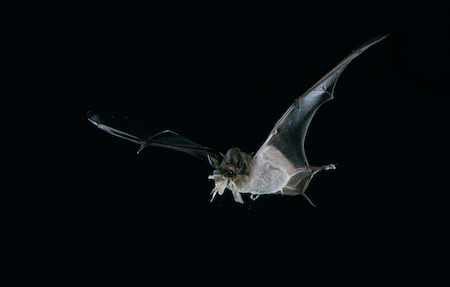A Bat Watch Experience at Agua Caliente Park
A dark shape flitted across the evening sky.
It was a bat, and as thousands of them took to the chilly air above Agua Caliente Park, these little silhouettes became harder to spot. Soon, the only evidence of their presence was the gentle sound of their wings.
Even if they weren’t visible, people were still tracking the bats. A group gathered by the pond, some looking up for bats while others focused on tablets in their hands. Each tablet showed bright waves shifting side to side, representing sounds. Occasionally, new bat silhouettes and a box of seeds appeared, indicating another bat nearby.
The tablets were equipped with a tool called the Echo Meter Touch, which identifies bats using sounds that human ears can’t hear. Bats produce these sounds and rely on the echoes bouncing back to navigate their surroundings and hunt for food, a skill known as echolocation.
“Identifying bats in flight on your own can be tricky,” said Jeff Babson, a specialist with Pima County’s Wildlife Viewing Program. “These devices we use are incredibly precise.”
Babson conducts several bat observation walks during the summer. He welcomes people of all ages, eager to learn more about these familiar yet elusive creatures.
“Most of the time, people are more fascinated by bats than afraid of them,” Babson noted.
Each tablet captures all bat calls recorded throughout the evening, contributing to a final archive that will be accessible to researchers. That night, a total of 2,329 bats from 16 different species were detected.
“You’re all part of community science,” Babson told his group.
As twilight deepened and stars appeared, Babson led everyone to another pond. The tablets had been quiet during the walk but came alive again as water came into view. Bats began to appear on the screens in succession.
“Bats need water just like we do,” Babson explained. “They require a reliable water source.”
Most participants had likely seen bats before. Pima County is home to countless bats, especially known for their roosts under bridges. Various locations in the county—from Campbell Avenue to Pantano Wash—are famous for where these animals can be seen emerging into the night.
“If you see a bat flying overhead, it doesn’t mean they came from right around here,” Babson cautioned. “Some of these bats can travel 30 to 40 miles just to find food.”
Bats may not be the first creatures that come to mind when thinking about desert wildlife, but they play crucial roles in the Sonoran Desert ecosystem, from pollinating saguaros and agaves to keeping mosquito populations in check.
Surprises can happen, too. Earlier this year, Mexican long-nosed bats were discovered expanding into southeastern Arizona, marking the 29th bat species found in the state.
Babson mentioned that these bats haven’t been seen yet; their presence was identified through DNA left at hummingbird feeders where they sip nectar.
“We rarely catch these bats on our detectors because they don’t echolocate much,” he said. “They mostly rely on their sight and sense of smell.”
He emphasized that bat walks help challenge common misconceptions about these creatures—many associate them with rabies or consider them dirty.
“Bats are actually quite beautiful,” Babson remarked. “They spend a lot of time grooming themselves, and in Arizona, rabies is more commonly contracted through skunk or fox bites.”
He still stressed the importance of observing bats from a distance and avoiding direct contact.
Even seasoned bat watchers find these animals mesmerizing. After all, bats are unique among mammals for their ability to fly, distinguishing them from creatures like flying squirrels. They are among only four groups in history capable of sustained flight, joining birds, insects, and ancient pterosaurs.
During the scorching summer nights, bat walks provide a wonderful chance to appreciate nature’s beauty.
“I think the bat walk experience is truly magical,” said Casey Limón-Condit, the community engagement and volunteer coordinator at PIMA County Conservation Lands & Resources.
“There’s nothing quite like being fully immersed in it. I find it beneficial, feel a sense of wonder, and it’s genuinely meditative. The darkness of the surroundings really heightens your senses.”
The next scheduled BAT Walks are on July 15, August 12, August 14, and August 21. For detailed schedules and additional information about the events, you can check the online calendar of Conservation Lands & Resources.







